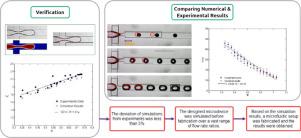European Journal of Mechanics - B/Fluids ( IF 2.6 ) Pub Date : 2021-06-30 , DOI: 10.1016/j.euromechflu.2021.06.013 Mostafa Soroor , Mohammad Zabetian Targhi , Seyed Ali Tabatabaei

|
Droplet-based microfluidic devices are widely used for drug delivery and cell transport. In most of these applications, flow characteristics and geometry strongly affect the droplet generation process. In this study, a flow focusing droplet generator was designed using numerical simulation. Among all the simulation methods, the 2D phase field method was used to predict the process in a newly designed microfluidic device before fabrication. To this end, the numerical method was verified according to previous research, including ten different cases, which demonstrated its applicability in this regard. The deviation of simulations from experiments was less than 5%. The device was then simulated over a wide range of flow rate ratios () and fabricated based on these results. Following fabrication, experiments were conducted for different ratios. The experimental results were compared with the simulations qualitatively and quantitatively. The investigation revealed pre-estimation effectiveness, indicating that the deviation of simulations from experiments was at most 11%. A wide range of from 0.25 to 1.05 was applied to study the droplet generation characteristics during the tests. Furthermore, two fundamental modes were introduced, and the flow regime shift from squeezing to dripping was studied over a wide range of . Given the droplets’ shape, the transition procedure is divided into three stages: pre-transition, transition, and post-transition. This study’s results can be used to investigate the capabilities of a newly designed microdevice before fabrication and choose the best flow regime that simultaneously reduces shear stress on cells and increases droplet generation frequency and monodispersity. Finally, this passive design can transport cells inside droplets up to 280 samples per second.
中文翻译:

基于流体聚焦液滴的微流体装置的数值和实验研究
基于液滴的微流体装置广泛用于药物递送和细胞运输。在大多数这些应用中,流动特性和几何形状强烈影响液滴生成过程。在这项研究中,使用数值模拟设计了一种流动聚焦液滴发生器。在所有模拟方法中,二维相场法用于在制造前预测新设计的微流体装置中的过程。为此,根据前人的研究,对数值方法进行了验证,包括十个不同的案例,证明了其在这方面的适用性。模拟与实验的偏差小于 5%。然后在很宽的流量比范围内模拟该设备() 并根据这些结果制作。在制造之后,针对不同的比率进行了实验。将实验结果与模拟进行定性和定量比较。调查显示了预估计的有效性,表明模拟与实验的偏差最多为 11%。范围广泛的应用从 0.25 到 1.05 来研究测试过程中的液滴生成特性。此外,引入了两种基本模式,并在广泛的范围内研究了从挤压到滴落的流态转变. 给定液滴的形状,过渡过程分为三个阶段:过渡前、过渡和过渡后。本研究的结果可用于在制造前研究新设计的微型器件的能力,并选择最佳流动方式,同时减少对细胞的剪切应力并增加液滴生成频率和单分散性。最后,这种被动设计可以在液滴内传输高达每秒 280 个样本的细胞。


























 京公网安备 11010802027423号
京公网安备 11010802027423号